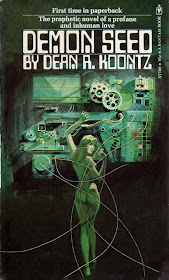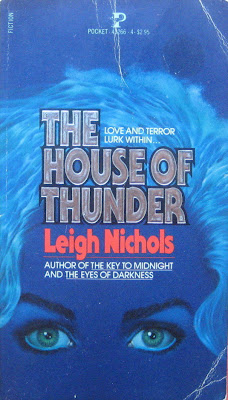How much of a book do you have to read before you decide to quit? Most readers hate leaving a book unfinished, and I'm no exception. When I was younger I left all sorts of classics half read - have
you ever tried to get through
Nausea,
The Magic Mountain, or all three volumes of
The Rosy Crucifixion? - but I'm usually able to finish most horror novels. But
Summer of Night, the sixth novel from
Dan Simmons, joins that sad small shelf of the unfinished (and damn, I just remembered - I never finished
Carrion Comfort when I tried to read it back in '90 or '91). Shame, because of course his debut novel
Song of Kali is great, as are the two
Hyperion novels, but otherwise I've not had much luck with the few other books of his I've tried. Really, I've got
so many other horror paperbacks waiting to be read...
Summer of Night is obviously Simmons attempting to set up camp in some familiar horror territory. However the book simply doesn't have its own
identity while laboring under the shadow of the largest horror of all,
Stephen King's 1986 thousand-plus-page
It.
Sure, Simmons writes without all the junky pop-culture
references that can clutter King's style, and actually I started to miss that as Simmons tries for universality and ends up with cliche, goes after
profundity but gives us triteness. In fact I didn't find it all that, uh, Kingian:
Summer of Night feels like it was plotted and written on
autopilot. Although I am sure much of it
is based on the author's own childhood, nothing feels real or lived. Everything could have been
written by someone who was simply regurgitating
It, maybe "The Body,"
maybe
Dandelion Wine with a smidge of
The Outsiders thrown in. Several
hundred pages elapse before we get any kind of real palpable
menace, madness, or evil, only threads of mildly interesting bits that dissolve into thin air.
Paperback edition Warner Books, Mar 1992
One major problem is that few of the children come truly alive as characters. The kids in this story aren't nearly as rag-tag as the Losers in
It; one is a devout Catholic who loves assisting "Father C" - you know, the cool priest - with Mass, and another is well on his way to becoming an overly bookish intellectual. Other kids in their gang are weakly drawn, meek and mild kids whom you can't really keep straight because they're all such squares. Strictly dullsville. The other problem for me was Simmons's story is
so normal and
so middle-America I wasn't fearful for the characters or the town's safety; I was bored nearly to death by its banal, prosaic lifelessness. But on I trudged, on past repetitive chase scenes and descriptions of summer evenings and fields of corn and gravel roads. Kids on bikes bug the fuck outta me, why do I wanna read an entire 600-page novel about 'em?
There is also a cloying sentimentality throughout the book, but especially in the last few pages - I cheated - that made me cringe. After surviving the epic final battle, the kids then sit around and talk about what they're going to do when they're grown up. Ugh. These passages aren't profound; they're mawkish and lazy and I could almost hear sappy orchestral strings from emotional '90s Hollywood flicks rising in the background. Even scenes of horror - if you stick around long enough to get to 'em - have been done before:
Father C's smile continued to broaden, pulling back to show his back teeth, broadening further until it seemed the man's face would snap in half as if on a hinge. The impossible mouth opened wide and Mike saw more teeth - rows and rows of teeth, endless lines of white that seemed to recede down the thing's gullet...
There were lamprey-like creatures burrowing beneath cornfields, chasing folks, in some cinematic sequences, cool, okay, but these scenes weren't anything fresh, almost rehashes of
Tremors. Scenes of characters investigating historical documents and ancient tomes to determine the true nature of their adversary is an aspect of horror fiction near and dear to my heart, but here it seems by-the-numbers. The bookish kid, Duane, tries to learn about the
Borgia Bell, supposedly hidden inside the public school's bell tower, and which may have supernatural properties, the well from which the horror springs. This simply did nothing for me, sounding more like a droning history lecture in a stuffy classroom.
Today it seems readers, going by reviews on Amazon, Goodreads, and various other blogs, love love
lurve this
Summer of Night. And I remember well back in the early '90s Simmons was riding pretty high, based on the originality of
Kali and the imaginative prowess of
Hyperion, as well as various very good short stories. But I can distinctly recall the disappointment I felt when
Summer of Night came out; this seemed like a huge step backward for Simmons. Growing up in 1960, kids face a monstrous evil? I really thought he could do better than that. I never once thought about reading it till I bought a copy - in mint condition, which was my true impetus for picking it up - two or three weeks ago, hoping maybe it'd be one of those great summer reads you lose yourself in. I was wrong.







+Cover+Jeff+Jones.JPG)

+Cover+-+Jeff+Jones.jpg)
+Cover+-+Jeff+Jones.jpg)
+Cover+-+Jeff+Jones+-.JPG)
+Cover+Jeff+Jones.jpg)
+Cover+-+Jeff+Jones.JPG)

+Cover++Jeff+Jones.JPG)

















